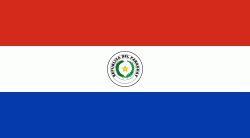Lima (Lima)
Lima is a town of the Department of San Pedro Paraguay.
One of the districts of the Second Department of San Pedro Paraguay, which is more than 330 km from the city Asuncion.
It was founded in 1792 and it is credited to Fray Pedro Bartolome, as a mission with Guanás Indians, on the shores of Aguaray River.
Lima was founded in 1901, as the 2nd district. Department of San Pedro.
With an area of approximately 992 km2, and an estimated population of 10,367 Inhab
Located on the River Aguaray Guazú, whose main activities are livestock, the exploitation of mate and some agricultural crops.
With its population of about 10,367 inhabitants it has a density of 13 inhabitants / km2.
It also has airfields for small and medium-sized machines.
One of the districts of the Second Department of San Pedro Paraguay, which is more than 330 km from the city Asuncion.
It was founded in 1792 and it is credited to Fray Pedro Bartolome, as a mission with Guanás Indians, on the shores of Aguaray River.
Lima was founded in 1901, as the 2nd district. Department of San Pedro.
With an area of approximately 992 km2, and an estimated population of 10,367 Inhab
Located on the River Aguaray Guazú, whose main activities are livestock, the exploitation of mate and some agricultural crops.
With its population of about 10,367 inhabitants it has a density of 13 inhabitants / km2.
It also has airfields for small and medium-sized machines.
Map - Lima (Lima)
Map
Country - Paraguay
 |
 |
| Flag of Paraguay | |
Spanish conquistadores arrived in 1524, and in 1537 established the city of Asunción, the first capital of the Governorate of the Río de la Plata. During the 17th century, Paraguay was the center of Jesuit missions, where the native Guaraní people were converted to Christianity and introduced to European culture. After the expulsion of the Jesuits from Spanish territories in 1767, Paraguay increasingly became a peripheral colony, with few urban centers and settlers. Following independence from Spain in the early 19th century, Paraguay was ruled by a series of authoritarian governments characterized by nationalist, isolationist and protectionist policies. This period ended with the disastrous Paraguayan War (1864–70), during which the country lost half its prewar population and around 25–33% of its territory to the Triple Alliance of Argentina, Brazil and Uruguay. In the 20th century, Paraguay faced another major international conflict—the Chaco War (1932–35) against Bolivia—in which it prevailed. Afterwards, the country came under a succession of military dictators, culminating in the 35-year regime of Alfredo Stroessner, which lasted until his overthrow in 1989 by an internal military coup. This marked the beginning of Paraguay's democratic era, which continues to this day.
Currency / Language
| ISO | Currency | Symbol | Significant figures |
|---|---|---|---|
| PYG | Paraguayan guaranà | ₲ | 0 |
| ISO | Language |
|---|---|
| GN | Guarani language |
| ES | Spanish language |















